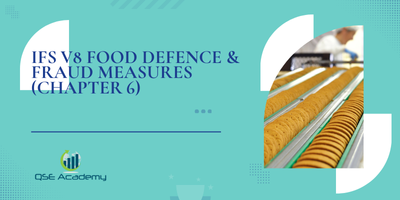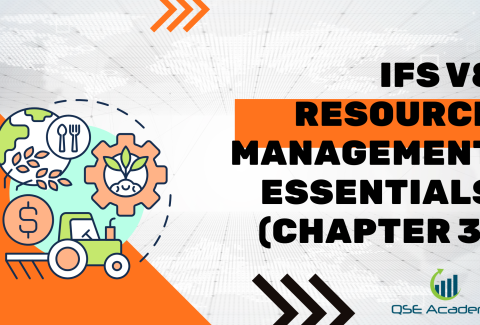IFS V8 Food Defence & Fraud Measures (Chapter 6)
Last Updated on November 17, 2025 by Melissa Lazaro
Protecting Food Integrity Beyond Compliance
Most companies are confident when it comes to food safety and HACCP. But when the conversation shifts to food defence or food fraud, things usually get quiet. And it makes sense — these programs feel more complex because they deal with intentional threats, not accidental ones.
IFS V8 places more emphasis on food defence and food fraud than previous versions, and for good reason. A contaminated product — whether accidental or intentional — damages customer trust, brand reputation, and regulatory compliance in the same way.
By the end of this chapter, you’ll understand:
- What IFS V8 expects for food defence and food fraud programs
- How to build risk-based, practical controls — not overcomplicated paperwork
- What documentation, monitoring, and evidence auditors will ask for
- The most common weaknesses facilities overlook
If your goal is to protect your business against deliberate contamination or fraudulent materials, this chapter builds that foundation.
Food Defence Requirements — Preventing Intentional Harm
Food defence focuses on protecting your site from deliberate contamination with the intent to cause harm. That could be external individuals, disgruntled employees, or unauthorized access.
IFS requires a structured food defence plan that includes:
- A vulnerability assessment (TACCP-style approach)
- Physical security controls (locked areas, restricted access, surveillance)
- Controlled entry for visitors, contractors, and service providers
- Clear response procedures in case of suspicious activity
It’s not enough to rely on “common sense.” Controls must be written, implemented, and tested.
One thing I’ve seen repeatedly: a company installs access-control badges, but doors are routinely propped open during busy shifts. That creates a gap between policy and practice — and auditors notice.
Pro Tip:
Walk the site during peak operational hours, not during audit prep. That’s when gaps appear.
 Food Fraud Vulnerability Assessment — Identifying Economic Threats
Food Fraud Vulnerability Assessment — Identifying Economic Threats
Food fraud is different from food defence. Instead of malicious intent to harm, food fraud focuses on economic gain — substituting, diluting, or misrepresenting a product to cut cost or increase profit.
IFS requires:
- A documented vulnerability assessment (VACCP method)
- Risk ranking based on likelihood and potential impact
- Data sources like historical fraud incidents, market intelligence, supply chain disruptions
- A review cycle tied to risk level and supply chain changes
One facility I supported discovered a high-risk ingredient simply because the global market price change made economic adulteration more likely. Without vulnerability monitoring, that threat would have gone unnoticed.
Pro Tip:
Use real-world sources — RASFF alerts, FDA recalls, industry bulletins — to support your vulnerability assessment.
Mitigation Strategies — Controls That Match the Identified Risk
Once vulnerabilities are known, mitigation isn’t meant to be theoretical — controls must be applied in real operations. Examples include:
- Supplier approval and verification testing
- Tamper-proof packaging seals
- Testing for authenticity or purity
- Enhanced traceability and chain-of-custody requirements
- Segregation or restricted storage for high-risk materials
The biggest mistake I see? Using a generic mitigation table copied from the internet. If controls don’t match your actual process or supply chain, auditors will mark it as incomplete.
Pro Tip:
Validation should happen before controls are finalized — not afterwards during the audit.
Monitoring, Verification & Testing — Making Sure Controls Actually Work
Monitoring confirms your mitigation activities are being carried out. Verification checks that the results meet expectations. Combined, they demonstrate system effectiveness.
IFS expects:
- Defined verification frequency
- Documented test results
- Independent review of findings
- Escalation and corrective action when controls fail
Testing alone isn’t enough — someone must evaluate the results and confirm they remain fit for purpose.
Common oversight:
Fraud mitigation testing is done, but the results never feed into management review or vulnerability reassessment — meaning improvement opportunities are missed.
Pro Tip:
Use simple dashboards or trend reports to avoid turning verification into a paperwork burden.
Documented Procedures, Incident Response & Crisis Communication
If something goes wrong — suspected intentional contamination, missing tamper seals, fraud indicators — your response must be fast and predictable. IFS requires a documented plan that includes:
- Roles and responsibilities
- Escalation triggers
- Decision-making steps
- Communication with authorities, customers, and internal leadership
- Investigation and corrective action
A response plan doesn’t need to be complicated — but it does need to be actionable under pressure. During drills, if people need to “search for the procedure,” the plan isn’t ready.
Pro Tip:
Run at least one drill annually — even a simple tabletop exercise counts.
Review Frequency & Continual Improvement — Keeping Protection Current
Supply chains change. Markets shift. New risks emerge. That’s why IFS requires routine updates to:
- Vulnerability assessments
- Food defence plans
- Mitigation strategies
- Verification schedules
- Incident response procedures
Reviews must occur:
- Annually (minimum)
- After major changes
- When new threats or supplier issues arise
- Following internal or external incidents
Food protection isn’t a one-time project — it’s an ongoing system requiring review and refinement.
FAQs
Do small sites need separate TACCP and VACCP teams?
Yes — but the team can be scaled. The key is competence, not headcount.
How often should risks be reassessed?
At least annually — sooner if supply chain or threat conditions change.
Is product testing mandatory for fraud mitigation?
Not always — but if risk exists, testing must be justified or replaced with an equally robust control.
Conclusion — Moving From Compliance to Protection Mindset
Food defence and food fraud programs are more than documents required for certification — they protect your brand, customers, and business.
When controls are risk-based, documented, and actively monitored, intentional threats become manageable — not unpredictable.
Melissa Lavaro is a seasoned ISO consultant and an enthusiastic advocate for quality management standards. With a rich experience in conducting audits and providing consultancy services, Melissa specializes in helping organizations implement and adapt to ISO standards. Her passion for quality management is evident in her hands-on approach and deep understanding of the regulatory frameworks. Melissa’s expertise and energetic commitment make her a sought-after consultant, dedicated to elevating organizational compliance and performance through practical, insightful guidance.








